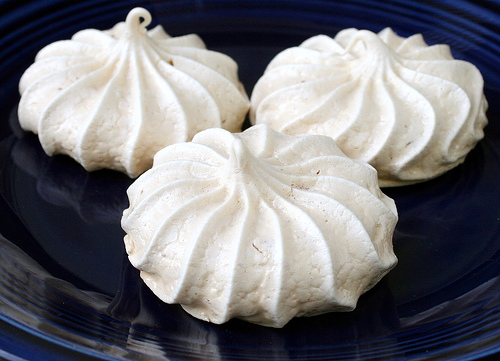Culture
The Hipster’s Cookbook: Meringues

Remember when we talked about how eggs are the easiest thing in the world to cook? Now I’m going to contradict myself a little bit and talk about meringues. Meringues are like that girl who tells you she’s low maintenance: If she has to make a point of saying something about it, she’s actually as high maintenance as they come. A correctly made meringue is a deceptively light concoction of egg white and sugar that literally melts in your mouth. There is no such thing as an incorrectly made meringue, because if you fail, your results are destined for the garbage bin.
At first glance, meringues do seem like they should be simple and straightforward. They require only two ingredients, with anything else being entirely optional. The problem, of course, is that the main ingredient is egg whites, which are incredibly finicky to work with. If you want to make meringue or anything else with egg whites, it would be wise to invest in an egg separator. This little gadget fits over the lip of a bowl so that if you crack an egg into it, the white falls into the bowl and the yolk remains in the separator. While you can also separate eggs using a spoon, it’s not really worth the risk of breaking the yolk, as even a drop of it will render the white useless. I’d recommend using three bowls for this process: one to separate the eggs into, one for storing the whites, and one for storing the yolks. There is nothing worse than breaking the yolk on the last egg and having it contaminate an entire bowl of egg whites.
To that note, you also need to make sure that your utensils are spotlessly clean, because greasy residue on a bowl will have the same effect as egg yolk, and the meringue will not stiffen. Metal or glass bowls work best because of science. (Plastic is porous and can have trace amounts of grease hiding on it.) Moisture is the death of meringues, so even though you need to add the sugar by spoonfuls, you need to do it quickly since sugar collects moisture from the air. If you’re planning on making meringue and it’s a humid day, change your plans. It just won’t work. If you’re planning on making meringue and you don’t have an electric mixer, think really hard about whether there was anything else you wanted to accomplish that day. It will work, but it will take forever and your arm will probably fall off.
So why bother? Despite all the hassle, meringues are very much worth knowing how to make. They make delightfully airy cookies and an impressive topping for pies and cakes. They’re also an important component in a variety of other foods, from sponge cakes to soufflés. And they’re delicious. This pie combines the juicy sweetness of peaches with the impression of eating a cloud to create a perfect summer dessert.
—–
Peach Meringue Pie
1 nine-inch pie crust
4 cups sliced peaches (Peeled is better, but you don’t have to if you’re feeling lazy.)
1 tsp lemon zest
1 tbs lemon juice
2/3 cup granulated sugar
1/8 tsp salt
¼ tsp cinnamon
2 tbs tapioca
1 tbs butter
3 egg whites
¼ tsp salt
½ tsp vanilla
6 tbs granulated sugar
1) Preheat the oven to 425 degrees. Use a fork to punch holes around the bottom and sides of the pie crust to prevent breakage.
2) Combine lemon zest, lemon juice, 2/3 cup sugar, 1/8 tsp salt, cinnamon, and tapioca in a small bowl.
3) Arrange half the peaches in the bottom of the pie crust, then top with half the sugar mixture.
4) Repeat with remaining peaches and sugar mixture.
5) Chop the butter into small pieces and sprinkle over the top of the pie.
6) Bake the pie at 425 for 35 minutes. While it is baking, beat egg whites, ¼ tsp salt, and vanilla with an electric mixer on high speed until foamy. Gradually add 6 tbs sugar by spoonfuls, while continuing to beat until the mixture holds soft peaks.
7) Remove the pie from the oven and reduce heat to 400 degrees. Pile the meringue on top of the pie, using a spoon to create peaks and whirls. Return to oven for 10-12 minutes, or until the meringue begins to brown lightly.
Pingback: Stories and flavors |()